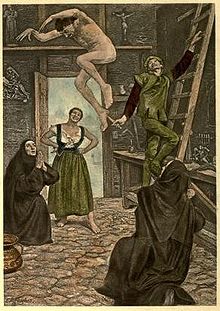The Facetious Nights of Straparola

Night the Ninth, Sixth Fable
Watercolor by E. R. Hughes
The Italian Novelists, Volume 3
The Facetious Nights of Straparola (
History
The Facetious Nights of Straparola was first published in
The work was modeled on Boccaccio's
The 15 fairy tales were influential with later authors, some were the first recorded instances of now-famous stories, like "
Fairy tales
Fairy tales that originally appeared in Nights of Straparola, with later adaptations by
Footnotes
- ^ Indicates sources which draw a connection between Straparola and the other folklorists for the given tale(s).
- Aarne-Thompson Index, separated this tale under a new type: ATU 510B*, "The Princess in the Chest", wherein the princess hides inside a closet or lantern to escape from an unwanted suitor.[5]
References
- ^ Greenwood Press, 2008, pages 926–27.
- ISBN 0-19-211559-6 See page 20. The claim for earliest fairy-tale is still debated, see for example Jan M. Ziolkowski, Fairy tales from before fairy tales: the medieval Latin past of wonderful lies, University of Michigan Press, 2007. Ziolkowski examines Egbert of Liège's Latin beast poem Fecunda Ratis (The Richly Laden Ship, c. 1022/24), the earliest known version of "Little Red Riding Hood". Further info: Little Red Pentecostal Archived 2007-10-23 at the Wayback Machine, Peter J. Leithart, July 9, 2007.
- ISBN 0-393-97636-X
- ISBN 9781442699519.
- ISBN 978-951-41-0963-8.
- ISBN 9783110317633.
- ProQuest 1922870374.
- Project MUSE 544012.
- ProQuest 196422641.
- ISBN 9781442699533.
Further reading
- Ruth B. Bottigheimer, Fairy Godfather: Straparola, Venice, and the Fairy Tale Tradition (University of Pennsylvania Press, 2002).
External links
- The Nights of Straparola, trans. W.G.Waters 1894. Scanned original color illustrated editions.
- The Italian Novelists (vol. 1–4), trans. W.G.Waters 1901–04. Scanned original color illustrated editions. Note: this edition differs slightly in content from the 1894 edition.
- SurLaLune Fairy Tale Pages: The Facetious Nights of Straparola
